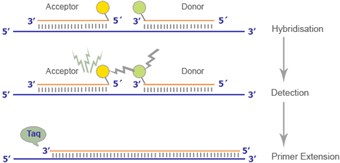Donor and acceptor probes to be used in FRET (fluorescence resonance energy transfer) assays. FRET probes support different instruments and multiplex analyses
LightCycler probes or FRET probes are hybridization probes based on the fluorescent resonance energy transfer (FRET) technique.
FRET probes consist of a pair of oligonucleotides (donor and acceptor) each labelled with a different fluorescent dye. Several fluorescent dyes for different instruments supporting FRET are available, and they are suitable for multiplex analysis.
Choose LightCycler Probes for:
- SNP detection
- Allele discrimination
- Pathogen detection
- Multiplexing
- Viral load quantification
- Gene expression analysis
- Gene copy determination
Several reporters are available and are suitable for multiplex analysis.
Benefits of Using LightCycler Probes include:
- Increased specificity
- Probe preserved during the reaction
- Increased thermal stability and hybridization specificity
- Greater accuracy in SNP detection and allele discrimination
- Easier and more sensitive probe designs for problematic target sequences
- Gene expression analysis
- Gene copy determination
What you can expect from our LightCycler probes
Product specifications:
- Final yields: 1, 3, 5 and 10 nmol
- Probe lengths: 15-40 bases
- HPLC purification is included
- Wobbles (non-defined ratio) possible
- TAT of 3-4 weeks
Principle of FRET probes
FRET probes consist of a donor and an acceptor probe.
Donor and acceptor are designed to hybridise to adjacent regions in close proximity to each other on the target DNA. The acceptor probe is labelled with a fluorescent dye at the 5' end and the donor probe with fluoresceine at the 3' end. Interaction of the two dyes can only occur when both dyes are bound to their target.

During FRET, the fluorescent donor molecule is excited by an external light source which subsequently transfers its energy to the acceptor fluorophore. The excited acceptor emits light of a different (longer) wavelength, which can be detected and measured.